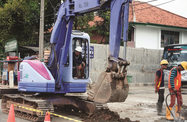The launch of an RM3bn ($984.15m) mixed-use development in Kota Kinabalu, the capital of Sabah, earlier this year is expected to provide a boost to the Malaysian state’s dynamic construction sector.
On February 25, SP Setia, a Malaysian property developer, inaugurated the Aeropod project, an integrated transportation centre also featuring residential, commercial and office space, after three years of studies. The venture will be completed in five phases over eight to 10 years and will span 28 ha when finished. It will host three hotels, 28,000 sq metres of retail space (including a shopping mall), office space, 5000 residential units, and the new headquarters of the Sabah Railway Department.
Aeropod was created in partnership with the Sabah government as part of a greater project to transform the Tanjung Aru railway station into a broader transportation centre. The first phase, to be finished in three years, will require RM235m ($77.09m) in investments and 11 ha of land. During this time, 28 units of shop lots – all of which have already been sold – will be built, along with the transport authority’s headquarters. This phase will also see the construction of Galeria, a visitor attraction that will feature an aquarium and a railway museum.
Another major project underway in Sabah is a high-value, upmarket resort set over a reef in the Celebes Sea. Set on more than 32.37 ha in Mabul Island, Alorie Lepa Resort will feature 88 pool villas. Construction for this venture, which required an investment of RM200m ($65.61m) from the Jewel of Mabul Development, a local hotel and resort developer, began in late 2011 and is expected to be finished by the first quarter of 2014.
These developments are expected to lure major investments to the Malaysian state. “The real estate sector in Sabah has experienced much growth in recent years, owing to investors’ confidence in the Sabah economy,” Musa Aman, the chief minister of Sabah, said. “We are seeing an upward trend in real estate value, not only in Kota Kinabalu, but also in other major towns like Sandakan, Tawau and Lahad Datu,” he said.
Commercial real estate is not the only area affected by the recent surge in construction. The energy sector is seeing several important projects as well, including plans to build a 300-MW power plant. The plant, backed by Tenaga Nasional, Malaysia’s largest electric utility company, is due for commissioning in 2015. The project is just one of many to benefit from the massive investments attracted by the palm oil industrial cluster (POIC). Since 2008, the POIC has drawn some RM4.5bn ($1.48bn) in investments and has facilitated the development of more than 600 ha of land and the construction of two sets of liquid-cargo jetties, a bulk jetty and industrial lots.
Major social projects are also in the pipeline. As part of Malaysia’s Rural Transformation Programme, 25 schools are scheduled to be built in the state. Unique to this project is the use of “green” construction techniques that utilise more fire- and wind-resistant materials. These techniques are part of the “industrialised building system”, a cost-effective method that would allow the schools to be completed in only two months.
Additionally, plans are in place to ensure that by the end of the year, Sabah will have 20 1Malaysia Clinics operating – the most for any state. At present, eight 1Malaysia Clinics are running, one was recently launched, one is in the construction phase and the location for the other 11 have been identified. They include Penampang, Beaufort, Sandakan, Kota Kinabalu and Keningau.
The high demand for construction projects is indeed a boon for the country, yet such growth does not come without challenges. One major concern, which particularly affects large construction projects employing many subcontractors, has to do with cash flow and adjudication. To address these issues, the government is in the process of passing legislation that would ensure payments for mega-construction projects are made in a timely fashion. The Construction Industry Payment and Adjudication Bill 2011 was approved on December 1, 2011 and is expected to be implemented at the end of this year.
With the surge in commercial real estate, the utilisation of cutting-edge, innovative techniques, and regulatory measures to safeguard investments, Sabah’s construction sector continues to demonstrate that it is ripe for investment.

